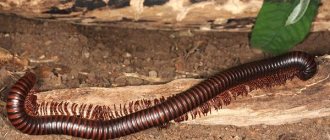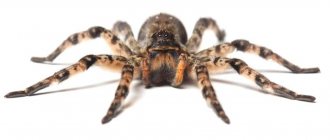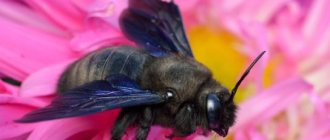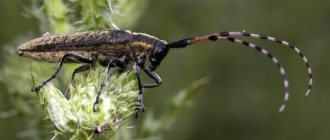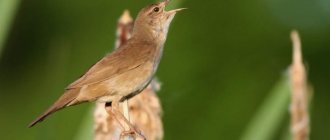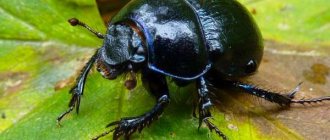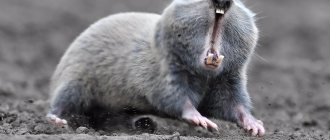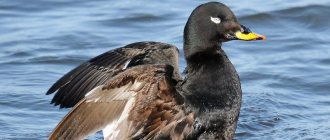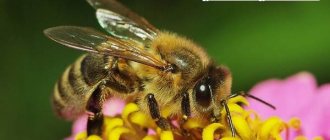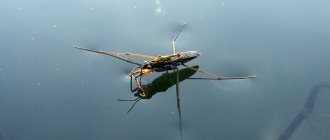The world around us is amazing. And one of the strangest creatures in it are centipedes. What do we know about them? Very few. And often we are simply afraid of these peculiar creatures, we avoid them or try to crush them. But not all of them are dangerous. If you take a little closer look at these invertebrates, it turns out that some are so harmless that they even pretend to be pets. But others are pests of our gardens and vegetable gardens. In this article we will talk about nods - creatures with a not very euphonious name, not a very attractive appearance, but living next to us so close that not trying to find out about them is simply unforgivable!
Kivsyaki - amazing centipedes
Keeping the rainbow nodule in captivity
A terrarium measuring 30x30x20 cm is suitable for a couple of animals. If possible, it is better to use a larger room for pets.
The larger the bottom area, the better. A mixture of coconut substrate, earth, sand and humus is used as soil. The soil should be loose and light, convenient for laying underground tunnels. It is good to add rotten wood and fallen oak or beech leaves to it.
To meet the calcium needs of the rainbow nodule, first place broken eggshells or natural chalk on the bottom of the terrarium, and 10-15 cm thick soil on top.
To create shelters, tree bark, branches and moss are planted. The optimal temperature is 20°-22°C with high humidity from 70 to 90%. Drying out the soil can lead to the death of the animal, so the terrarium must be sprayed from the inside daily with warm water from a spray bottle.
To lay eggs, the female burrows into the soil. Shedding also takes place there. After each molt, the larva gains one body segment with a pair of legs. They become sexually mature at about 3 years of age. Males on the seventh segment lack a pair of legs and instead have a gonopodium.
We invite you to familiarize yourself with the Meat breed limousine
In a terrarium with a volume of 80x40x40 cm you can simultaneously contain 4-6 giant nooses. They do not need additional lighting. To observe their behavior, just turn on a low-power night lamp.
The temperature is maintained in the range from 25°C to 30°C. At night it is lowered slightly, but not below 20°C. Pets need high air humidity, especially at night. It is advisable to maintain it at 85% by spraying the walls of the terrarium with warm water in the evenings.
Its layer must be at least 10 cm. The use of peat is strictly prohibited due to its high acidity. It destroys the exoskeleton, which inevitably leads to the death of the pet.
Before use, the substrate is sifted to remove unwanted residents (ants, beetles, worms and larvae). It should be moist but not wet. It needs to be changed annually.
You can feed any vegetables and fruits, after peeling them. The need for proteins is satisfied by periodically introducing food for aquarium fish, cats and dogs into the diet. It is given occasionally and in small quantities. If there is a lot of foliage in the terrarium, then fertilizing is done once a month.
There is no need to install drinking bowls. Animals obtain the necessary moisture from food. To provide them with calcium, crushed eggshells are added to the food or substrate.
Nutrition
Kivsyaks are often called gluttons, because in one month they consume a bucket of food. Their diet consists of mushrooms, rotten shoots, bark, and so on. However, when caring for a centipede in an apartment, you don’t have to worry about its diet, because it is omnivorous. Eats both meat products and dairy products (cottage cheese). Some people feed their pets fruits, vegetables and any other plant foods.
A notable fact about diplopods is that they often eat chalk. This is due to the content of calcium and vitamins in the composition (they strengthen the shell). Chalk can be replaced with egg shells. You should not give too much food, otherwise mold will begin to form on the leftover food. Therefore, they should be removed immediately.
A favorite place for breeding is considered to be a manure heap, which is why many summer residents often find these invertebrates in the ground. If you do not take any measures to combat them, they will soon begin to gnaw on the roots, as a result of which the plants will simply stop growing normally due to lack of nutrients. It is not always possible to see such small pests, because their length is a maximum of one and a half centimeters.
As mentioned earlier, the color of the shell of centipedes depends on their variety. They are black, white, olive, yellow, brown. Their bodies have a large number of warts and sparse setae; each segment contains two pairs of legs.
Quite often, nodules end up on tubers along with manure. That is why, before buying any fertilizer, it is recommended to carefully inspect it and check for the presence of these small pests and their larvae.
To prevent unexpected “guests” from appearing on your site, the gardener should periodically clean the soil and greenhouse (remove plant debris), and also treat the soil annually using chemical and thermal methods.
Lifestyle and reproduction
The arthropod prefers to behave secretly. During the day it hides in rock cracks, under stones, trees and other similar places where it is not so hot. So, the scolopendra is hiding from its enemies - various mammals and birds who are not averse to hunting it. At night, the centipede comes out of hiding in search of various invertebrates, which are its main food.
Surprisingly, the huge scolopendra has poor eyesight. More precisely, it distinguishes only between light and darkness. Because of this, she behaves aggressively - in any incomprehensible situation (for example, meeting a person or animal), she prefers to attack, suspecting danger.
The giant scolopendra is capable of developing decent speed when hunting, and the agility and mobility of its body allows it to attack even small and nimble birds.
Scolopendras are individualists and live alone. They rarely conflict with each other. Having met, two individuals usually disperse peacefully. Scolopendra reaches sexual maturity at 2-3 years of age. In this case, the female can mate several times within one year.
By the way, this unpleasant animal is considered a caring mother. Scolopendra protects the eggs and hatched offspring by wrapping their legs around them. It can thus cover the entire clutch, which can contain up to 100 centipedes. The female fiercely attacks everyone who approaches the shelter and her children. At the same time, the giant scolopendra not only protects the eggs, but also cleans them, applying special substances to them so that they do not become covered with mold or dirt, and also do not dry out.
Small white centipedes are born. They have soft bodies a couple of centimeters long. They don’t live with their mother for long – after a few days they go out on their own to look for food. The plates on the shell of centipedes gradually darken. But their color changes until they reach maturity.
For reference! The ancestor of scolopendra gigantea is believed to be the prehistoric scolopendra arthropleura. The length of her body could reach 2.5 meters. There was such an ancient and huge centipede approximately 300-340 million years ago.
How to get rid of nodule?
Before choosing any control method, you should pay attention to agrotechnical treatment. It is recommended to destroy all weeds, get rid of fallen leaves, boards and manure, where weeds can hide and breed
It is important to correctly identify the pest. The centipede damages roots, berries, stems, roots and leaves
Most often, the damage appears minor and consists of a small gnawed “hole.” However, due to such damage, plant growth slows down and the fruits become unsuitable for consumption. Root vegetables, such as beets or carrots, darken and begin to rot especially quickly. Despite the insignificant degree of damage, the plant dies quite quickly.
Chemicals
In the fight against most pests, this option is the most effective. But noddy is an exception. A durable chitinous shell protects it from the effects of insecticides. And even treating plants eaten by this arthropod does not give the desired result. Chemicals can destroy only the larvae, and less often the eggs of centipedes. However, this method of control rarely allows you to completely get rid of the squid population.
To combat larvae, effective means are “Fury”, “Aktofit”, “Decis”, “Zemlin”, etc.
Treatment with solutions of chloride salts is considered the safest. But when choosing this method, it should be taken into account that an excess of salt in the soil is dangerous for all plantings.
Traditional methods
Such methods in most cases involve repelling pests using odors. These can be infusions or solutions. However, the nods do not react too strongly to such methods of struggle. The most effective option is to plant repellent plants, namely white mustard. By the way, it will not only repel centipedes, but will also have a beneficial effect on the soil.
But the most effective method of dealing with nodule is mechanical treatment. When using this method, various traps are created. Typically they are represented by the following options:
Boards. You need to make depressions between the beds and cover them with boards or plywood. During the day, arthropods actively hide in such places. It is necessary to periodically lift the board and remove pests. Can or bottle. Near the habitat of centipedes, you need to place a jar in the ground
It is important that it is exactly at ground level. Trying to cross the obstacle, some of the nods will fall inside. Bait
Can be used either separately or in conjunction with previous methods to increase efficiency. It is best to take potatoes, carrots, beets or other vegetables as bait. Strawberries are also acceptable. Kivsyaks need to be collected by hand, but it is better to wear gloves to protect the skin from their secretion.
Compost pits are an effective trap. By maintaining favorable conditions for the centipede there, the degree of pestilence can be temporarily reduced. However, the main task is to wait until late autumn. When cold weather sets in, you need to dig out the heap; all the nooses will be left without shelter and die.
Prevention
The best way to combat a pest is to avoid its appearance on the site. Most of the rules of prevention include soil cultivation. Required elements are:
- earlier spring cultivation;
- regular loosening of the top layer of soil;
- late autumn plowing;
- liming of the earth;
- mulching strawberries with straw;
- removal of all damaged fruits;
- timely harvest.
A large amount of debris in the area can also cause millipedes to appear. The invertebrate often hides under old things that have not been used for a long time. Possible shelters should be destroyed in advance.
It is recommended to take special care when purchasing and applying manure, humus and compost. This is the most common reason for arthropods to enter an area
It is important to first verify the complete absence of pests or completely abandon the use of organic fertilizers
Centipedes in the house: a scary neighborhood
Centipedes often appear in the house. They come to a person’s home in search of food: cockroaches, bedbugs, fleas, moths. The need for moisture forces people to live in the basement, bathroom, or basement. To hunt, centipedes can crawl out of their hiding places into other rooms. A centipede bite is usually not dangerous. The exception is poisonous species living in regions with warm climates. In temperate latitudes, there are individuals that are unable to bite through human skin. Moreover, arthropods cannot be called aggressive creatures that attack people. On the contrary, very often when large animals, and especially humans, appear, they hurry to retreat.
But still, the inhabitants of the premises in which these creatures have appeared often begin to look for ways to get rid of the centipede at home. This is mainly due to disgust and disgust for creatures whose appearance can hardly be called attractive. Although some exotic lovers keep arthropods as pets.
What to do?
How to get rid of a house centipede that has become an uninvited guest? First of all, you need to inspect the ventilation shafts in the bathroom and toilet, and also check the grilles in the floor. These are the main routes of entry into arthropods. If necessary, you can install a mosquito net on them, and then periodically treat it with insecticides.
It is important to remember that the centipede does not live in dry areas. Therefore, if a faucet is leaking somewhere, then the malfunction must be repaired.
She also needs a lot of food, and most likely there are many other pests in the house that need to be dealt with.
Chemical insect control agents
There are no specific drugs to combat the millipede. You can use universal insecticides against it:
- the well-known “Dichlorvos”;
- aerosol "Raid";
- gel against cockroaches "Great Warrior"
- "Medilis-Ziper" is a toxic, but very effective remedy.
But it is useless to use sticky traps - only a few legs will remain on them, which will be a minor loss for the centipede.
The only harm that a centipede brings to the house is the psychological discomfort of being in its proximity. To get rid of it, you need to fight other insects and high humidity; and also use special insecticidal agents.
Conditions of detention
Your pet will be comfortable in a terrarium in which the free area of the bottom is important. The bottom should be twice the length of the nodule's body.
Since the usual habitat for the noose is withered foliage, cover the bottom of the terrarium with a thick layer of soil and foliage. Don’t forget to moisten the substrate and mix in lime. When changing bedding, leave some of the old one. This will preserve the symbiotic union. Microorganisms living in the soil are involved in the millipede's digestion.
By maintaining a temperature of 23-28 degrees Celsius and a humidity of about 70-90%, you will ensure comfortable living conditions for the inhabitant of the glass house. Holes for ventilation and regular spraying of the soil will add joy to the recruit.
Symbionts usually settle next to the peace-loving creature - these are woodlice or earwigs. But ticks are even considered an indispensable addition to the meal. These parasites usually go through life in tandem with the African nodule. Previously it was believed that they needed this symbiosis. Recent scientific research has refuted these arguments, so it makes sense to get rid of uninvited guests immediately. To do this, the worm must be thoroughly rinsed under running water. There is an opinion that you can wipe it with alcohol.
Shedding
From time to time, you may notice that the appearance of your Cavalier's shell has begun to dull - this is a sign that shedding is about to begin. Do not worry. He will endure the “change of wardrobe” courageously, burying himself in the bedding, moving very little during this time. Stays in silence, darkness and solitude until the new “clothes” are completely strengthened. This usually takes from 2 to 4 weeks.
TIP: During this period, you need to add calcium to your diet. Decaying bark and leaves are a source of calcium in the natural habitat.
In our case, a regular pharmaceutical drug can help, which any pharmacist at a veterinary pharmacy will offer you. As a source of calcium you can use:
- Shell rock (limestone);
- dolomite flour;
- natural chalk;
- sepia (cuttlefish shell);
- egg shells;
- mollusk shells.
Place the inhabitant's house in a secluded place, protected from direct sunlight. This way you can watch him during the day. Nooses are afraid of bright light and often spend time buried in the soil. The contents of the nooks are pleasant, you can pick them up. They are quite friendly. At first, however, they will curl up into a ball - this is their defensive reaction. The second defensive reaction is their secretion of a brown liquid. It has been noticed that during a long stay with the owners in the same living space, this function atrophies in them. Perhaps they simply stop being afraid and feel completely safe.
In the early stages of becoming acquainted with this brotherhood, try to promptly wash off the brown protective liquid from your hands. Beware of getting it on the mucous membranes of the eyes and nasopharynx, it can cause allergies, especially in children. In this matter, thin silicone gloves can serve you well.
Lifestyle
surrounding the centipede includes a considerable number of diverse living organisms. It spends its entire life on the forest floor; it digs out passages in the ground. The fact that the noon has many legs is not always able to help it avoid the threat of a dangerous predator, because it is very slow.
By her character you can understand that she is a phlegmatic person. And this is a consequence of the fact that she has no dangerous opponents in nature. The only creatures that bother them are parasitic mites. To protect and scare away predators, they emit a foul odor and wrap themselves in a tight ball. His favorite pastime is to bury himself in the ground and slowly become numb.
The smell emitted by centipedes helps not only themselves, but also some other animals. As evidence, we can say about the lemur, which, when danger comes, intimidates the nook and rubs its body with its odorous secretions. This is how he manages to escape from his opponents.
Many are of the opinion that how nasty the odor of the kiwi is directly depends on its color. For example, white diplopods smell really very unpleasant. However, this does not stop people who are passionate about exotics, and they are often interested in breeding such squids at home.
However, hobbyists often keep African snakes, which are similar to ordinary snakes, except that they have numerous legs. The box or something similar where they will live should be made of plastic or glass. They are easy to care for. Keeping kissyaks has a number of disadvantages.
The main one is excessive timidity, as a result of which centipedes curl up in a tight ring and emit a nasty smell. It is recommended to use gloves before handling centipedes. After all, discharge easily stains clothes. They are very peaceful, calm, but unsociable. The price for one kivsyak reaches about six hundred rubles.
Terrarism / Other animals → African hawk (Archispirostreptus gigas)
Scientific name: Archispirostreptus gigas
Size: up to 30 cm
Origin: Eastern, Southeast Africa
Daytime temperature: 25-29°C
Night temperature: 21-23°C
Humidity: 80-90%
Terrarium size: 40x40x30 cm
Substrate: Coconut substrate mixed with soil. Oak and beech leaves, both dry and green.
Toxicity: Extremely low, allergic reactions are possible with iodine intolerance.
Temperament: Very calm, slow. In case of danger, they curl up into a ball and secrete an irritating liquid with a pungent odor of iodine.
Note:
Giant African centipedes, or Archispirostreptus gigas, can be found more and more often in home collections of exotic animals. African nooses grow to very large sizes and are easy to keep at home, live from 7 to 10 years, and are practically harmless.
The defensive reaction manifests itself in two types. First type: Rolling into a ball to protect softer tissues and legs. Type two: secretion of iodine-based fluid that causes skin irritation. After handling your pet, you must wash your hands. The liquid is dangerous if it comes into contact with the mucous membranes of the mouth, nose, or eyes. Upon contact with the skin, it is completely absorbed in less than five to seven hours. Giant African centipedes have up to 400 legs, and when they molt, new segments grow, adding four legs each.
Determining the sex of Archispirostreptus gigas is a simple process. Males have a so-called “gonopod” on the seventh segment from the head; visually, there are no legs on this segment. Breeding grasshoppers is not difficult. Just place the male and female in a spacious container with the necessary conditions and in a few weeks you will see the larvae
Attention, do not throw away the top layers of the substrate, they contain eggs and larvae!
Archispirostreptus gigas, as I have already noticed, are not picky and very easy to care for. Giant African centipedes are kept at a temperature of 25-29°C and a humidity of 80-90%. The main diet is vegetables and fruits; pears and cucumbers are very popular. Try varying the diet to give them everything they need, and at the same time you will find out what your pet likes best. Also, ducklings need protein and calcium! It is necessary to constantly add crushed eggshells or chalk to the food and soil, and add cat food from time to time. If you do not follow this simple rule, after some time the shell of the noon will fall apart into segments and the animal will die.
Archispirostreptus gigas is accompanied everywhere by ticks. These mites are harmless in small quantities; they clean the areas between the legs, but in large quantities they irritate the animal; mite larvae can clog the respiratory openings. To remove, you can place the centipede in a warm bath and use a small, soft brush. Many sources claim that mites cause fungal infections of the feet of the noose.
Translation: semantik13, from open foreign sources
Giant African centipedes, Archispirostreptus gigas Now, a few words from myself
I received a nodding female with a length of 21 centimeters (autumn '10). There were no problems with maintenance at all, after some time he got rid of the ticks, and he still lives and does not die, contrary to popular belief. Due to the transition to more complex living creatures, the nod had to be given away. According to the new owners, “the booger makes the children happy, no problems have been identified.” Body length is 25.5 centimeters (winter-spring '11). Loves champignons, lettuce, Chinese cabbage. With great pleasure he cracks apples, especially red ones, watermelon, melon. The animal is absolutely problem-free! The only drawback is that it is secretive, but it quickly spreads out in your hands and begins to crawl. If you don't squeeze, you won't see the iodine :). There is one unpleasant feature - it can land on your palm or clothing. Traces disappear from the skin within a day, but there will be problems with clothes, since iodine is a caustic liquid. Good luck to you and your pets!
Here you can read my thread about ticks and see photos.
Diet
You can include in your pet's daily menu:
- cleaning vegetables and fruits,
- cucumbers,
- berries,
- cereals,
- green leaves.
The best delicacy is raw and slightly rotten tree bark. It is preferable to serve raw food to a new household member; it may not be the freshest food. Cat food containing vitamins and microelements will be useful, at least once a month. A prerequisite is to add lime to the food - this is the main building material for the formation of a pet’s protective shell. You can use ground eggshells. Change and renew the litter, which is also used.
Ghana gharial
The Ghanaian gharial is a reptile of the order of crocodiles, but despite its impressive size and the presence of a huge number of teeth, it does not pose a danger to humans. Gharials are rare ancient animals on the verge of extinction that live in the north of the Hindustan Peninsula. They live in calm areas of deep rivers and very rarely go onto land. Over centuries of close cooperation with gharials, people have become convinced that this scary-looking animal does not pose a threat to humans. The only trouble is that there is an opinion among fishermen that gharials are responsible for the decline in fish populations, but at the same time in India they are still considered sacred animals and they do everything to preserve the population of these unusual reptiles.
Are they dangerous for indoor plants?
Centipedes are dangerous for plants. You can create favorable conditions for the development of an animal by regularly pouring the remaining tea leaves into a flower pot. First, the nods will eat the remains of the organic matter, and then they will start on the flower itself.
These centipedes can harm indoor plants
If new residents are ignored, the colony of pests will rapidly increase, destroying indoor plants in the home. It's easy to eliminate kiwi. Simply place the flower pot in a bucket of water. The animal will float up. It is necessary to collect and destroy the pest.
Who are the nods?
Kivsyak is a terrestrial invertebrate, a bipedal centipede. There are more than 7 thousand species of them on the planet. Their body, which can grow up to 30 cm (long-bodied individuals live in the tropics), does not contain eyes and has a protective shell. It is this that prevents chemicals from penetrating into the body and protects against mechanical damage. The first three segments of the body do not contain limbs, and the remaining 27 segments contain 2 pairs of legs.
The body is white or beige with various inclusions. These spots correspond to holes that release a protective secretion, and the antennae help these creatures sense the environment.
The temperate latitudes of our country are inhabited by the noose, which lives in the forest zone. It brings benefits by processing rotted remains of vegetation. In middle latitudes there is a gray noose, the size of which is 20-50 mm. Also living here is a sandy representative of this type of centipede; its body color is black with orange stripes.
The life of the noose is quite long - up to 5 years. During this time, they lay eggs multiple times.
Interesting!
Mating of the nooses occurs only in warm, not dry weather. And feeding occurs only at night. They can be found on the surface in humid and damp weather.
Pieces of soil and excrement serve as building material for their nest. Eggs mature in about 3 weeks under favorable conditions. When the larvae emerge, they resemble mature moths, although their body segments are much smaller. Pest larvae molt several times, acquiring pairs of legs and additional segments after each process.
In winter, centipedes are located far in the soil. At this time, they experience physiological inhibition in the metabolic processes of the body. Not only mature individuals, but also larvae are capable of this.
Pests of cultivated plants
Gardeners often encounter strawberries on strawberries. You can only notice them on a cloudy day. The pest hides from the sun and is active at night. Signs of damage are holes in the berries, sometimes a larva appears in them. Strawberries become unfit for food.
In the cold and wet season, centipedes damage plant roots and root crops - carrots, beets, radishes. Speckled grasshopper causes damage to the garden. This species is light in color with red spots on the segments. Depending on age, it is brown or black, lives 4-5 years. Its length is 8-14 mm. Females lay up to 70 eggs in the soil. After birth, the larvae have only three pairs of legs. The development of centipedes from larva to adult lasts 1-3 years.
Information. An overgrown population of grasshoppers can harm agricultural crops. They are able to eat more than their own weight in food per day.
Destruction with baits
The most popular method among people to get rid of centipedes is to feed them with pieces of root vegetables loaded with insecticides. The bait is scattered throughout the area. This simple method requires regular troubles: moistening the bait, renewing it, protecting it from rain, and collecting bait.
Therefore, they complicate it:
- At the bottom of the funnels, trapping containers (glass jars, cans with vegetables) are buried;
- the bait is placed under an opaque heat-light-moisture insulator (board, plywood).
Arthropods readily use such shelters, from which they are systematically removed.
Disadvantages: baits are good when a limited number of individuals have locally settled in a small space. If several colonies have become neighbors, individual selection is unlikely to solve the problem. At the same time, it is necessary to meticulously clear all traps of individuals attracted from all over the area, otherwise the destruction of the nodule will imperceptibly turn into its breeding.
Woodlice Dalmatians and Oranges (Porcellio laevis Dalmatian and Orange)
I didn’t even expect that woodlice would please me so much. After all, these crustaceans are more like a fodder crop, but no, these are large, and they grow up to 2 centimeters, they are very decorative and very interesting. And it can be used as food.
I already have six species of woodlice, most of them are no more than a centimeter, but these Dalmatians and orange ones are real cows. Very large, cool and active crustaceans.
They eat mainly rolled oats, gammarus, cucumber peelings, and bell peppers. You definitely need a lot of calcium in piles on the ground.
Pieces of bark, twigs and rotten wood are really needed. Some branches and bark can be stuck into the ground vertically in short pieces up to 10 centimeters, or a large flat one can be placed on two branches lying on the ground, so that it is like a roof in the form of a house and only a centimeter or less above the substrate. Woodlice love such surfaces and are very fond of vertical ones; it is more convenient for them to live on them and it is easier for them to shed. And it’s convenient to spray on these pieces of wood. Below, in the shot with orange woodlice, I turned over one such bark. From below, they eat away the surface, which serves as both food and shelter.
Even the passages in the bark are eaten away. But many people do exactly the same thing. They are very similar in content. And woodlice (this species) do not require high humidity; standard periodic moistening is sufficient. But I will write separately and a lot about woodlice, and this article is more about the nooses, so let’s put the crustaceans aside and let’s continue about the other centipedes that I still have.
How to get rid
Most often, grasshoppers end up on the site along with contaminated manure. Therefore, before purchasing it, conduct a thorough visual inspection. Manure mixed with straw is especially dangerous, since it is in it that grasshoppers reproduce best.
Try to remove all plant debris from the soil in a timely manner, as well as fight weeds. Treat the seed material before planting in a weak solution of potassium permanganate, this will prevent the development of many diseases that provoke rotting processes, and accordingly will significantly reduce the nutritional base of this pest. Additionally, it is recommended to treat the seeds with karbofos and pyrethroids for the same purpose.
At the end of the summer season, it is advisable to disinfect the soil in greenhouses using a chemical or thermal method. In November, carry out deep plowing of the land, thereby disrupting the sweet life of the comfortably settled nodules and their larvae. A heat-loving pest that finds itself near the surface will most likely die from the cold.
Be sure to lime the soil with eggshells, dolomite flour, wood ash, chalk or lime (recommendation for acidic soils). Such treatment will force the nodule to look for a new habitat.
Green manures planted in the soil help very well in combating green manure. After the harvest is harvested, plant the area with white mustard. This plant will not only drive away the noose, but will also greatly improve the quality of the soil.
In severe cases, you should resort to using dry insecticides. “Pochin”, “Zemlin”, “Grom-2” have proven themselves well in practice, thanks to the diazinon they contain. The drug “Counter” also gives good results. Among liquid insecticides, we can recommend Fury, Decis and Karate.
From an environmental point of view, it is preferable to treat the soil with solutions of chloride salts. It is advisable to add them to the soil in the evening, when the nooses begin to emerge from their shelters (these creatures are active at night).
Often good results are obtained with baits containing poison (chopped potatoes and other root vegetables mixed with insecticides).
Between the beds with vegetable crops, you can periodically lay out boards. In dry weather, the nooses will certainly gather under them (since in such places the soil remains moist), where they can be quickly collected and destroyed.
Prevention
In order not to have to fight with nodule on the site, it is easier to prevent its appearance. To do this, it is recommended to follow the rules of agricultural technology.
- Deep digging of the soil in early spring and late autumn.
- Liming the soil, adding lime, ground shells, and crushed chalk is also very useful.
- In autumn, all plant debris must be carefully removed from the beds and row spacing so that diplopods cannot overwinter in them.
- Ripe fruits (berries, vegetables, etc.) and carrion must be collected in a timely manner.
- The beds should be covered with mulch and covering material so that centipedes cannot reach the fruits.
- When adding manure and humus, it is worth checking it for the presence of nodule.
- Since diplopods often settle in heaps of construction waste, boards and other waste, it is advisable not to litter the area and remove the garbage in a timely manner.
- Planting green manure will enrich the soil with nitrogen and reduce the number of unwanted soil inhabitants.
Deep digging
Types of nods
Among the common and well-studied species of diplopods are the following:
Sandy nod
One of the types of centipedes common in Russia. The color is black, on the back there are two bright orange stripes located longitudinally. It is found in light forests - pine, oak, beech or in fields. Prefers sandy soils with leaf litter. Body length 25-45 mm, feeds on rotten fruits and plant debris. Leads a nocturnal lifestyle.
Olive nod
A large representative of the centipede family that lives in the tropical forests of Africa. The length of individuals is 22-24 cm. They prefer to go out to feed at dusk. The main body color is olive; in addition, each segment is colored with red-brown rings. The legs are striped, the antennae are olive. The number of body segments during life reaches 68-75. When maintaining a home, it is advisable to purchase a large terrarium. The centipede prefers the coolness of the night; it is recommended to lower the temperature to 21-22 in the evening.
The maintenance of the olive tree is quite simple; you will need a layer of soil in which you can dig holes. The pet quickly gets used to the person. He rarely releases poisonous secretions and crawls around your hands with pleasure. There are no food preferences; they give rotten wood, leaves, and fruits. To increase calcium levels, add crushed eggshells or shells to the diet.
Rainbow nod
The diplopod is distinguished by its spectacular coloring, iridescent in several colors. The main body tone is blue-gray, with a black ring on each segment. There is a longitudinal red stripe on the back; the limbs, antennae and head are painted in the same color. There is a spike-shaped process on the tail. The length of the body is 10-12 cm. Its homeland is Southeast Asia. When maintaining a house, it is necessary to take into account the peculiarity of the species - the noose bites when hungry. It does not harm a person, but rather reminds one of responsibilities.
Crimean kivsyak
Among the centipedes of Crimea, the nodule stands out for its harmlessness. A small representative of its species (4-5 cm). Color – dark gray with a steel tint. This slow-moving creature can be found swarming in the foliage of the park, crawling along paths and walls. Surprisingly, the number of legs of the nodule is 740. This species does not bite, its secretions are not poisonous, but have an unpleasant odor.
Madagascar nodule
Representatives of this species are not large in size, their length is 10-12 cm. The popularity of centipedes was brought by their bright coloring - the upper part of the body segments is red, they are separated from each other by dark rings. The legs are orange. Habitat is Madagascar.
Giant nodule
Large centipedes are interesting to keep at home. The giant nodule, reaching a length of 30 cm, is a welcome pet in the terrarium. Its body is black and shiny, its limbs are red. Fans of exotic animals keep them in home insectariums - plastic containers with a layer of soil and plants. Having seen the giant, many wonder whether the nod is dangerous for humans? You can pick up a peace-loving creature, the main thing is not to scare it. The centipede secretes a poisonous secretion that irritates the mucous membranes.
Desert nod
A native of the USA and Mexico, it grows up to 12-14 cm. Its color matches the color of the desert soil - reddish-brown. The centipede can go without water for a long time and eat the bark and leaves of shrubs. Active during the rainy season, with the onset of summer drought it goes deep into the soil.
What does the animal eat?
The animal has extraordinary gluttony. In 30 days, the nodule destroys a bucket of food. The diet is based on leaves and mushrooms. Additionally, they consume tree bark and organic matter.
When kept at home they are omnivorous. They consume food indiscriminately, including meat. It is interesting to know that the noose loves chalk and eats a substance to strengthen its shell. Instead of such a treat, the animal is given crushed eggshells.
When maintaining a home, leftover food should be removed regularly. This will prevent mold from developing.
Noiseweeds are pests. They often live in summer cottages. They eat plant roots. The seedlings stop developing fully. The supply of required nutrients from the mail stops.
They often settle under strawberry bushes
Over time, damaged plants die completely. The gardener risks losing his harvest. Elimination measures should be taken as early as possible.
The animal's favorite place to live is strawberries. The representative can get under a berry bush along with low-quality manure. Therefore, the choice of fertilizers should be approached responsibly.
Kinds
Giant nodule is one of the most interesting subspecies. The number of their legs reaches seven hundred. They look like a huge worm. Typical habitat Africa is a place where many varieties of this subspecies exist.
The diplopod's head contains small antennae, segments, and olfactory and tactile organs. The centipede itself is a single organism, protected by strong “armor”, which is quite hard to the touch (this in turn helps the insect to avoid damage). Shades – yellowish, brownish.
In nature, there are still individuals with very dark “armor” and even with an interesting “pattern” on it. African nodule has reddish, yellowish and bluish shades. This species is the largest, native to East Africa. Females are slightly smaller than males. Over the course of a year, their length increases by 0.5 decimeters. Calm, non-aggressive.
Millipedes also have other colors of “armor”, for example, olive nodule. His body shimmers with dark (a combination of green and gray) shades. The segments are clearly demarcated. Lives in southern Africa. The eggs are laid in a dung heap. In the wild they live up to 7 years, in captivity this number can increase several times. The individual is less timid than the others, and therefore emits odorous liquid less often.
Rainbow nod has an interesting name for a reason. It is characterized by grayish and black shades of the shell; there is a red line on the body. The length of the insect is up to twelve centimeters. This species often lives in Thailand and Vietnam. It feeds on fallen leaves and lives in them. When hungry it bites.
